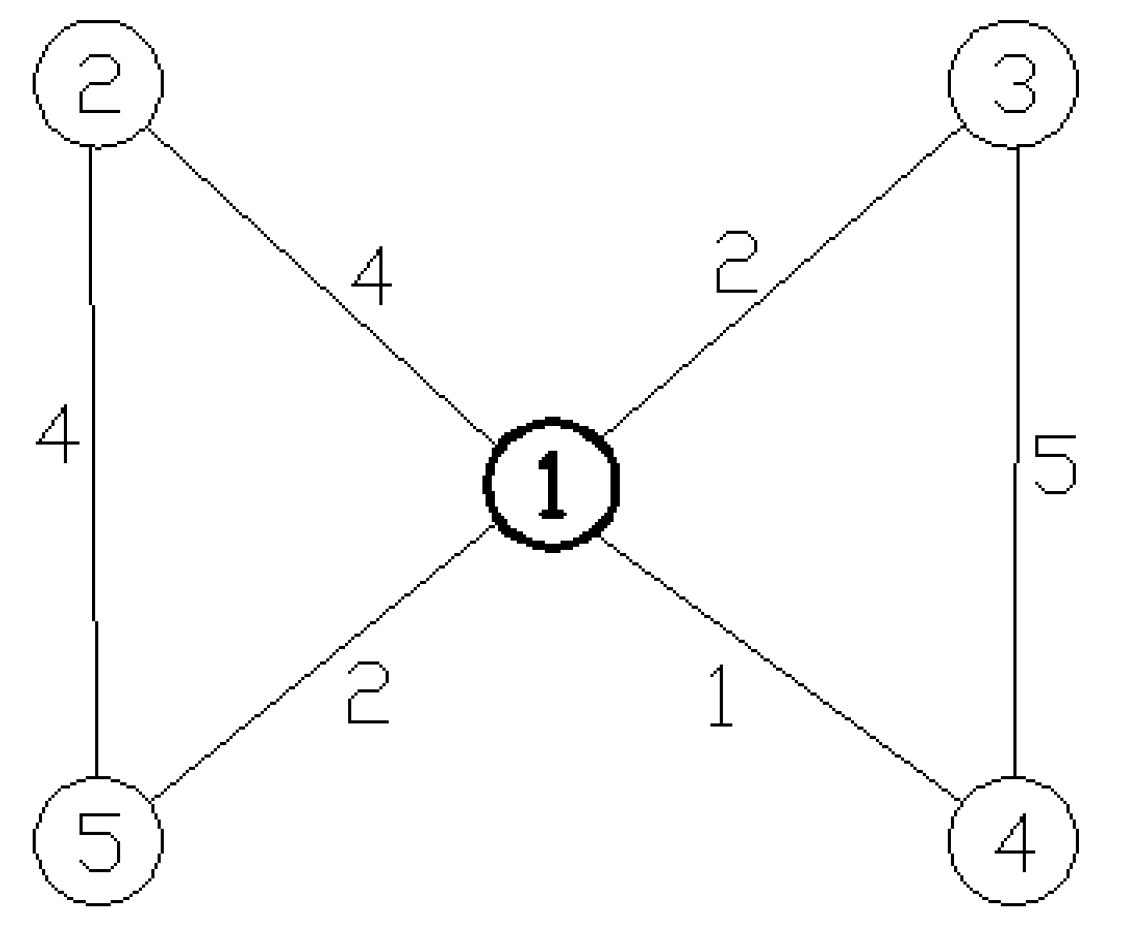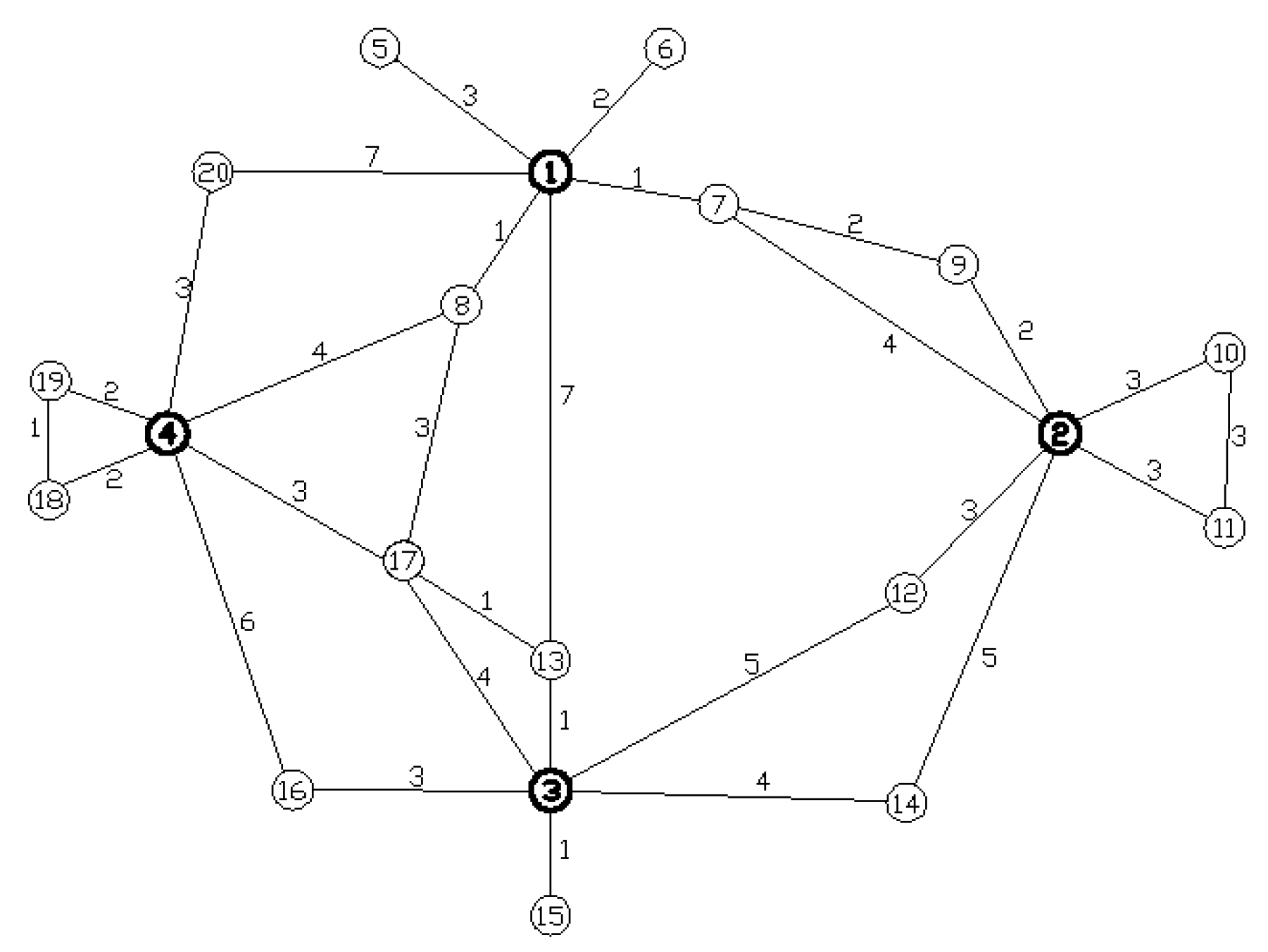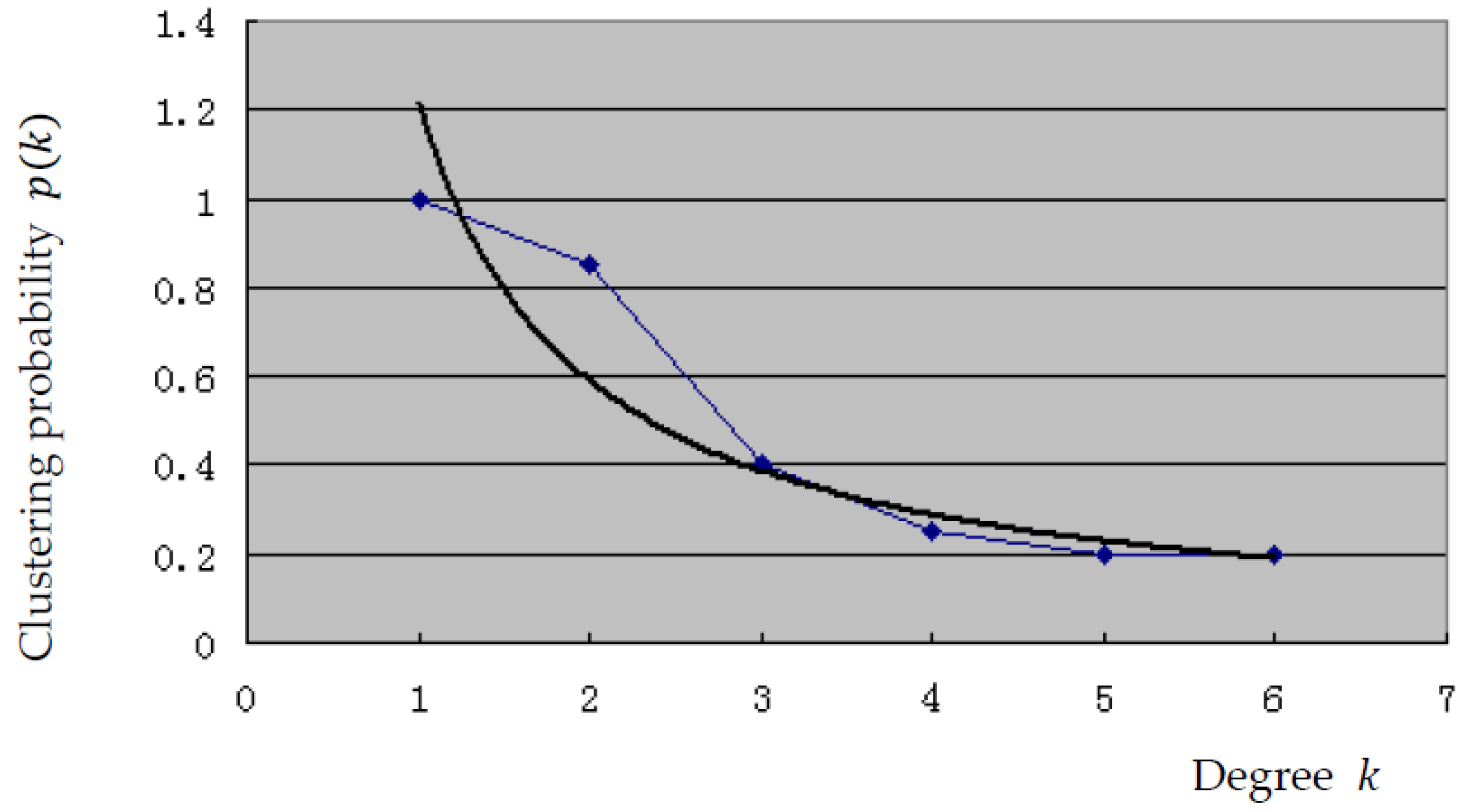On the Simulation-Based Reliability of Complex Emergency Logistics Networks in Post-Accident Rescues
Abstract
:1. Introduction
2. Complex Emergency Logistics Network Connotation and Its Statistical Characteristics
2.1. Topological Structure of Complex Emergency Logistics Network
2.2. The Statistical Characteristics of a Complex Emergency Logistics Network
3. Connecting Reliability of Emergency Logistics and Its Evaluation Index
- (1)
- Emergency supply time
- (2)
- Ratio of effective demand nodes
4. Simulation Method of Emergency Logistics Network Attack
4.1. Attack Types of Emergency Logistics Network
- (1)
- Random attacks occur randomly at each node and are typically observed in situations such as natural disasters, accidents, and partial failures.
- (2)
- Selective attacks occur based on the number of direct connections, usually in descending order. These attacks are typically observed in situations such as terrorist attacks and blocking at major nodes.
4.2. Simulation Pattern and Method of Random Attack
- (1)
- Initialize the adjacency matrix . If there is a side connecting , directly, then is the transportation time between the two nodes. If there is no direct connection between , , = ( is the emergency time limit).
- (2)
- Assume that is a member of set , and , = , = (=1,2,…, n).
- (3)
- Based on Dijskra, calculate the minimum transportation time of each demand node. The first step is to calculate the minimum transportation time from supply node to all demand nodes , where is the sequence number of supply nodes, is the number of times needed to obtain the minimum transportation time (nodes marked with ) from supply nodes outward (according to Dijskra), and is the sequence number of a certain node.
- (4)
- Calculate the minimum transportation time of the next supply node to all demand nodes. is the value of supply node . If the value is greater than that of the previous supply node , then the minimum transportation time is the value calculated in Step (3), and .
- (5)
- Repeat Step (4) until all supply nodes and the transportation time of all demand nodes have been calculated, where is the sequence number of the last supply node.
- (6)
- Calculate the emergency supply time . If the transportation time of one demand node is < , the node is an effective demand node. Thus, the total number and ratio of effective demand nodes can be obtained. The arithmetic mean of the transportation time of all demand nodes is the emergency supply time .
- (7)
- Randomly generate another integer in the set (except ) and assign , = , = .
- (8)
- Return to Step (3) and repeat the process until all integers in the set have been used.
4.3. Simulation Method of Selective Attacks
5. Case Study of Simulation Analysis
5.1. Marking of Network Type
5.2. Simulation Results and Its Analysis
- (1)
- Special attention should be paid to the protection of supply nodes and nodes with high connectivity, such as emergency logistics conversion nodes. A dynamic, flat emergency supplies reserve mechanism and network should be established. The market-oriented storage and government reserves should be combined with the integration of the central and local emergency supply nodes to achieve the linkage between the reserve nodes.
- (2)
- We should accelerate the construction of an emergency logistics channel so that we can find an alternate link when one link is blocked in post-accident rescue. After the timeliness and safety of transportation routes are focused on, several alternative transportation plan should be prepared in advance, the corresponding alternative transportation plan will be immediately activated in post-accident rescue.
6. Conclusions
Acknowledgments
Author Contributions
Conflicts of Interest
References
- Erkut, E.; Verter, V. Modeling of transport risk for hazardous materials. Oper. Res. 1998, 46, 625–642. [Google Scholar] [CrossRef]
- Carter, W.N. Disaster Management: A Disaster Manager’s Handbook; Asian Development Bank: Mandaluyong City, Philippines, 1992. [Google Scholar]
- Abounacer, R.; Rekik, M.; Renaud, J. An exact solution approach for multi-objective location–transportation problem for disaster response. Comput. Oper. Res. 2014, 41, 83–93. [Google Scholar] [CrossRef]
- Guan, X.; Ge, C.; Wang, X.; Wang, G. Models and algorithms for hub and spoke locations for emergency service facilities in response to serious emergency incidents. Hum. Ecol. Risk Assess. Int. J. 2013, 19, 553–565. [Google Scholar] [CrossRef]
- Razi, N.; Karatas, M. A multi-objective model for locating search and rescue boats. Eur. J. Oper. Res. 2016, 254, 279–293. [Google Scholar] [CrossRef]
- Jin, W.; An, W.; Zhao, Y.; Qiu, Z.; Li, J.; Song, S. Research on Scheduling Optimization of Marine Oil Spill Emergency Vessels. Aquat. Procedia 2015, 3, 35–40. [Google Scholar]
- Nolz, P.C.; Semet, F.; Doerner, K.F. Risk Approaches for Delivering Disaster Relief Supplies. OR Spectr. 2011, 33, 543–569. [Google Scholar] [CrossRef]
- Wang, W.; Huang, L.; Guo, Z.X. Optimization of Emergency Material Dispatch from Multiple Depot Locations to Multiple Disaster Sites. Sustainability 2017, 9, 1978. [Google Scholar] [CrossRef]
- Afshar, A.; Haghani, A. Modeling integrated supply chain logistics in real-time large-scale disaster relief operations. Socio-Econ. Plan. Sci. 2012, 46, 327–338. [Google Scholar] [CrossRef]
- Wagner, M.R.; Radovilsky, Z. Optimizing Boat Resources at the U.S. Coast Guard: Deterministic and Stochastic Models. Oper. Res. 2012, 60, 1035–1049. [Google Scholar] [CrossRef]
- Taghipourian, F.; Mahdavi, I.; Mahdavi-Amiri, N.; Makui, A. A fuzzy programming approach for dynamic virtual hub location problem. Appl. Math. Model. 2012, 36, 3257–3270. [Google Scholar] [CrossRef]
- Ai, Y.F.; Lu, J.; Zhang, L.L. Optimized location-allocation model for water emergency supplies repertories under triangular fuzzy demand. J. Saf. Environ. 2016, 16, 179–183. (In Chinese) [Google Scholar]
- Najafi, M.; Eshghi, K.; Dullaert, W. A multi-objective robust optimization model for logistics planning in the earthquake response phase. Transp. Res. Part E Logist. Transp. Rev. 2013, 49, 217–249. [Google Scholar] [CrossRef]
- Lu, C.C. Robust weighted vertex p-center model considering uncertain data: An application to emergency management. Eur. J. Oper. Res. 2013, 230, 113–121. [Google Scholar] [CrossRef]
- Ben-Tal, A.; Chung, B.D.; Mandala, S.R. Robust Optimization for Emergency Logistic Planning: Risk Mitigation in Humanitarian Relief Supply Chains. Transp. Res. Part B Methodol. 2011, 45, 1177–1189. [Google Scholar] [CrossRef]
- An, Y.; Zeng, B.; Zhang, Y.; Zhao, L. Reliable p-median facility location problem: Two-stage robust models and algorithms. Transp. Res. Part B Methodol. 2014, 64, 54–72. [Google Scholar] [CrossRef]
- Zeng, B.; Zhao, L. Solving two-stage robust optimization problems using a column-and-constraint generation method. Oper. Res. Lett. 2013, 41, 457–461. [Google Scholar] [CrossRef]
- Hong-Minh, S.M.; Disney, S.M.; Naim, M.M. The Dynamics of Emergency Transshipment Supply Chains. Int. J. Phys. Distrib. Logist. Manag. 2000, 30, 788–817. [Google Scholar] [CrossRef]
- Hamedi, M.; Haghani, A.; Yang, S. Reliable Transportation of Humanitarian Supplies in Disaster Response: Model and Heuristic. Procedia Soc. Behav. Sci. 2012, 54, 1205–1219. [Google Scholar] [CrossRef]
- Ducruet, C.; Notteboom, T. The worldwide maritime network of container shipping: Spatial structure and regional dynamics. Glob. Netw. 2012, 12, 395–423. [Google Scholar] [CrossRef] [Green Version]
- Kaluza, P.; Kölzsch, A.; Gastner, M.T.; Blasius, B. The complex network of global cargo ship movements. J. R. Soc. Interface 2010, 7, 1093–1103. [Google Scholar] [CrossRef] [PubMed]
- Montes, C.P.; Seoane, M.J.F.; Laxe, F.G. General cargo and containership emergent routes: A complex networks description. Transp. Policy 2012, 24, 126–140. [Google Scholar] [CrossRef]
- Shafiee, M.E.; Berglund, E.Z. Agent-based modeling and evolutionary computation for disseminating public advisories about hazardous material emergencies. Comput. Environ. Urban Syst. 2016, 57, 12–25. [Google Scholar] [CrossRef]
- Dengiz, B.; Altiparmak, F.; Smith, A.E. Efficient optimization of all-termina1 reliability reliable networks using an evolutionary approach. IEEE Trans. Reliab. 1997, 41, 18–26. [Google Scholar] [CrossRef]
- Edrissi, A.; Nourinejad, M.; Roorda, M.J. Transportation network reliability in emergency response. Transp. Res. Part E Logist. Transp. Rev. 2015, 80, 56–73. [Google Scholar] [CrossRef]
- Watts, D.J.; Strogatz, S.H. Collective dynamics of ‘small-world’ networks. Nature 1998, 393, 409–410. [Google Scholar] [CrossRef] [PubMed]
- Barabási, A.L.; Albert, R. Emergence of scaling in random networks. Science 1999, 286, 509–512. [Google Scholar] [PubMed]
- Albert, R.; Barabási, A.L. Statistical mechanics of complex networks. Rev. Mod. Phys. 2002, 74, 47–97. [Google Scholar] [CrossRef]
- Albert, R.; Jeong, H.; Barabási, A.L. Error and attack tolerance of complex networks. Nature 2000, 406, 378–382. [Google Scholar] [CrossRef] [PubMed]





| Node Number | Degree | Clustering Coefficient | Node Number | Degree | Clustering Coefficient |
|---|---|---|---|---|---|
| 1 | 6 | 0 | 11 | 2 | 1 |
| 2 | 6 | 0.13 | 12 | 2 | 0 |
| 3 | 6 | 0.67 | 13 | 3 | 0.33 |
| 4 | 6 | 0.13 | 14 | 2 | 0 |
| 5 | 1 | 0 | 15 | 1 | 0 |
| 6 | 1 | 0 | 16 | 2 | 0 |
| 7 | 3 | 0.33 | 17 | 4 | 0.33 |
| 8 | 3 | 0.33 | 18 | 2 | 1 |
| 9 | 2 | 1 | 19 | 2 | 1 |
| 10 | 2 | 1 | 20 | 2 | 0 |
© 2018 by the authors. Licensee MDPI, Basel, Switzerland. This article is an open access article distributed under the terms and conditions of the Creative Commons Attribution (CC BY) license (http://creativecommons.org/licenses/by/4.0/).
Share and Cite
Wang, W.; Huang, L.; Liang, X. On the Simulation-Based Reliability of Complex Emergency Logistics Networks in Post-Accident Rescues. Int. J. Environ. Res. Public Health 2018, 15, 79. https://doi.org/10.3390/ijerph15010079
Wang W, Huang L, Liang X. On the Simulation-Based Reliability of Complex Emergency Logistics Networks in Post-Accident Rescues. International Journal of Environmental Research and Public Health. 2018; 15(1):79. https://doi.org/10.3390/ijerph15010079
Chicago/Turabian StyleWang, Wei, Li Huang, and Xuedong Liang. 2018. "On the Simulation-Based Reliability of Complex Emergency Logistics Networks in Post-Accident Rescues" International Journal of Environmental Research and Public Health 15, no. 1: 79. https://doi.org/10.3390/ijerph15010079






